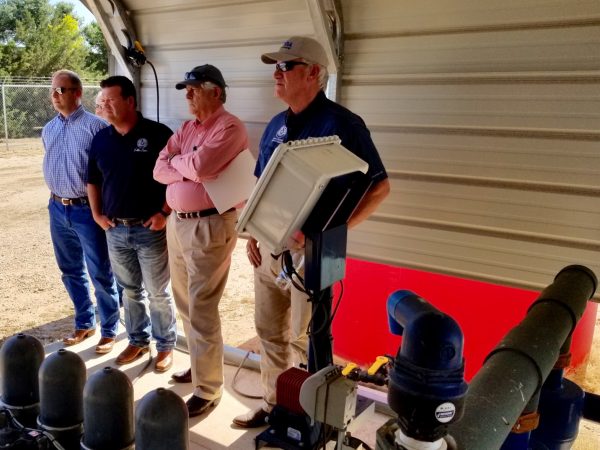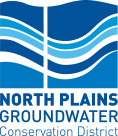House Committee Visits Panhandle for Public Input
Contact: Julia Stanford, jstanford@northplainsgcd.org or 806-930-6934
The Texas Legislature ended its 85th session in the summer of 2017, but your legislators are hard at work in the interim period until they return to the Capitol in 2019. In both the House and the Senate, policy makers have honed in on water law, permitting, and groundwater conservation districts. North Plains Groundwater Conservation District was given a unique opportunity to meet with members of the House Natural Resources Committee to share the geology of the region, district rules and permitting processes, and the success of agricultural conservation programs.
As an overview, 31 senators and 150 representatives make up the Texas Legislature. The 8-county area that makes up the North Plains Groundwater Conservation District is represented by Sen. Kel Seliger. In the House of Representatives, Dallam and Hartley counties are served by Rep. John Smithee; Sherman, Moore, and Hutchinson counties are served by Rep. Four Price; and Hansford, Ochiltree, and Lipscomb counties are served by Rep. Ken King. In every odd-numbered year, the Legislature convenes in January at the state Capitol in Austin for a 140-day regular session to develop and vote on bills that may become law. When not in session, legislative committees are asked to research and seek public input on interim charges and develop a committee report to guide the legislative process upon return to the Capitol. Last October, Lt. Gov. Dan Patrick issued 81 interim charges to the Senate, and Speaker Joe Straus issued 230 interim charges to the House.

House Natural Resource Committee members (left to right) Four Price, DeWayne Burns, Paul Workman, and Chairman Lyle Larson learn about subsurface drip irrigation at the North Plains Water Conservation Center.
The focus of a recent public hearing held by the Senate Committee on Agriculture, Water, and Rural Affairs stems from Sen. Charles Perry’s Senate Bill 1392 filed in the last regular session. The purpose of this bill is to amend current law relating to groundwater conservation districts (GCDs) found in Chapter 36 of the Texas Water Code. The changes are intended to reflect the results of recent court cases and ensure that the groundwater regulations are based on science and impartial toward to all beneficial uses of water. A major point of contention is the concept of “similar rules,” meaning that all GCDs that share a common reservoir (the Ogallala Aquifer, for example) must have similar rules that are developed cooperatively.
At a public hearing held on June 4th at the Capitol, the committee received testimony from several groundwater professionals regarding the interim charge titled “Regulatory Framework of Groundwater Conservation Districts and River Authorities.” Representing the first GCD created in the state of Texas, Victoria Messer Whitehead gave invited testimony detailing the geology-based delineation of the High Plains Underground Water Conservation District (HPWD) that covers all or part of 16 counties in a subdivision of the Ogallala Formation south of the Canadian River. She continued to describe the graduated scale used in HPWD’s well spacing regulations and its distinct regulatory framework utilizing over 90 county committee members that advise the district on local matters within their communities.
Russell Johnson is an attorney based in Austin who described himself as the voice of negativity before he explained that “regulation should be by aquifer, or at least by regions of aquifers, and not by groundwater district boundaries.” After declaring that GCD boundaries are “ridiculous” everywhere except for the Texas Panhandle, Johnson said “Your fair share shouldn’t depend on which side of the county line you live on.”
C.E. Williams, General Manager of Panhandle GCD, discussed data from a study regarding similar rules among GCDs in the joint planning group Groundwater Management Area 1 (GMA-1). A 100-question survey among the 4 districts revealed that their rules were at least 92% similar to one another, meaning that a very large portion of the Ogallala aquifer in Texas is being managed consistently over the many square miles, water uses, and diverse geography in GMA-1. Williams explained some of the variation with his closing statement: “Local management is the most difficult way to manage groundwater, but it’s also the best because it takes into account the producers and the people that have to comply with the rules on a day to day basis, and it protects their private property rights.”
Sen. Charles Perry serves as the chair of the Committee on Agriculture, Water, and Rural Affairs. His response to Williams recognized the unique issues present within the Texas Panhandle and GMA-1, stating that the population density is different than in other parts of Texas. Perry also addressed the region’s reliance on agriculture as a factor in determining Desired Future Conditions, or DFCs: “You guys have different DFCs in parts of that, because you can’t grow corn where there’s no water anymore. Y’all are very much exactly the example where I think science supports the differences in pumping and well spacing… Similar rules doesn’t mean everybody’s the same, similar rules means that the approach and logic for the rule was the same.”
Another focus of the proposed amendments to Chapter 36 is exporting water out of its original basin. Currently, the Texas Water Code allows GCDs to limit groundwater production if the water will be transported out of the district. SB 1392 includes amendments affirming that the right to export groundwater is of equal dignity with the right to produce groundwater. Urban centers in Texas are experiencing rapid population growth and turning to rural communities rich in groundwater resources to satisfy their water supply deficit. While selling groundwater rights can provide an economic benefit to rural landowners, Sen. Lois Kolkhorst argued at the public hearing that it can be detrimental to struggling small communities: “We’re giving up a resource to allow other parts of the state of Texas to grow, while we aren’t growing.”
On the same day of the Senate committee public hearing, staff and directors of the North Plains Groundwater Conservation District (NPGCD) welcomed members of the House Committee on Natural Resources to our North Plains Water Conservation Center north of Dumas. In attendance were Committee Chair Lyle Larson, Four Price, DeWayne Burns, Paul Workman, and several of their staff members. The committee learned about the district’s production limits and metering requirements, economic development of the area, alternative crops, geology of the district and its boundaries, inflows from New Mexico, and conservation education.
Four Price expressed his pride in NPGCD’s innovative Master Irrigator adult education program, which recently garnered the district its second Texas Environmental Excellence Award. Representatives and their staff toured the Water Conservation Center to see agricultural conservation in practice on the district’s 320-acre demonstration farm. With two center pivot irrigation fields and 40 acres outfitted with subsurface drip irrigation, the farm is an authentic example of how producers can use water more efficiently and maintain or even increase their yield and profitability. Committee members asked many questions, and at the end of the day Chairman Larson praised the conservation efforts of farmers in the Panhandle. Recognizing that most groundwater use in Texas is for crop irrigation, he suggested that people in urban centers need to be made aware of the strides that are being made in agricultural water conservation.

NPGCD Director Bob Zimmer speaks to Chairman Lyle Larson about innovations in center pivot irrigation.
Armed with an enhanced knowledge of water use in the Texas Panhandle, The House Committee on Natural Resources took their turn at a public hearing at Palo Duro Canyon State Park on Tuesday, June 5th. The testimonies at the House committee hearing were very similar to those heard at its Senate counterpart, with many of the invited speakers traveling straight from the Senate hearing to testify at the House hearing. The interim charge issued to the committee was to evaluate the status of groundwater policy in Texas, including issues regarding case law development, consistency in aquifer-wide management, improvements to permitting processes, brackish groundwater research, water supplier service areas, and data needs.
Lynn Tate is the President of the Board of Directors for HPWD. He provided testimony to educate the committee on the usability of the Dockum aquifer as a groundwater resource. Many groundwater producers in the HPWD use water solely from the Dockum for daily use, however in another area the water has a salinity three times that of seawater. He recommended that the Dockum aquifer need not be designated as a groundwater production zone since it is already being produced.
Rick Kellison is the Project Director of the Texas Alliance for Water Conservation (TAWC), and a farmer. His testimony confirmed what the committee members learned about in the previous day’s outing with North Plains GCD – that growers are great stewards of their natural resources. The objective of the TAWC is to promote water conservation and “provide a bridge between producers and researchers.” After Kellison’s testimony, Chairman Larson reiterated the need to communicate successes in agricultural conservation to the masses in Texas’ urban areas.
Part of the interim charge was to evaluate groundwater data and science needs, and Sarah Schlessinger from the Texas Alliance of Groundwater Districts (TAGD) described the efforts of a grant-funded Texas Water Data Initiative and listed the greatest data and science needs as determined by a TAGD subcommittee. Among those are groundwater withdrawal data, groundwater monitor wells, updated groundwater availability models, water quality data, data collection tools, and aquifer storage and recovery. Schlessinger mentioned an identified need for “decentralized hubs” for water data and related that concept to the existing groundwater conservation districts.
After the public hearings, committee members will use what they learned to produce an interim report to be delivered to their leadership and made public. The report will guide the committee members as they develop and evaluate bills in the regular session beginning next January. The legislative interim period is an important process for our lawmakers and a time for the public to provide vital information to the legislators.
